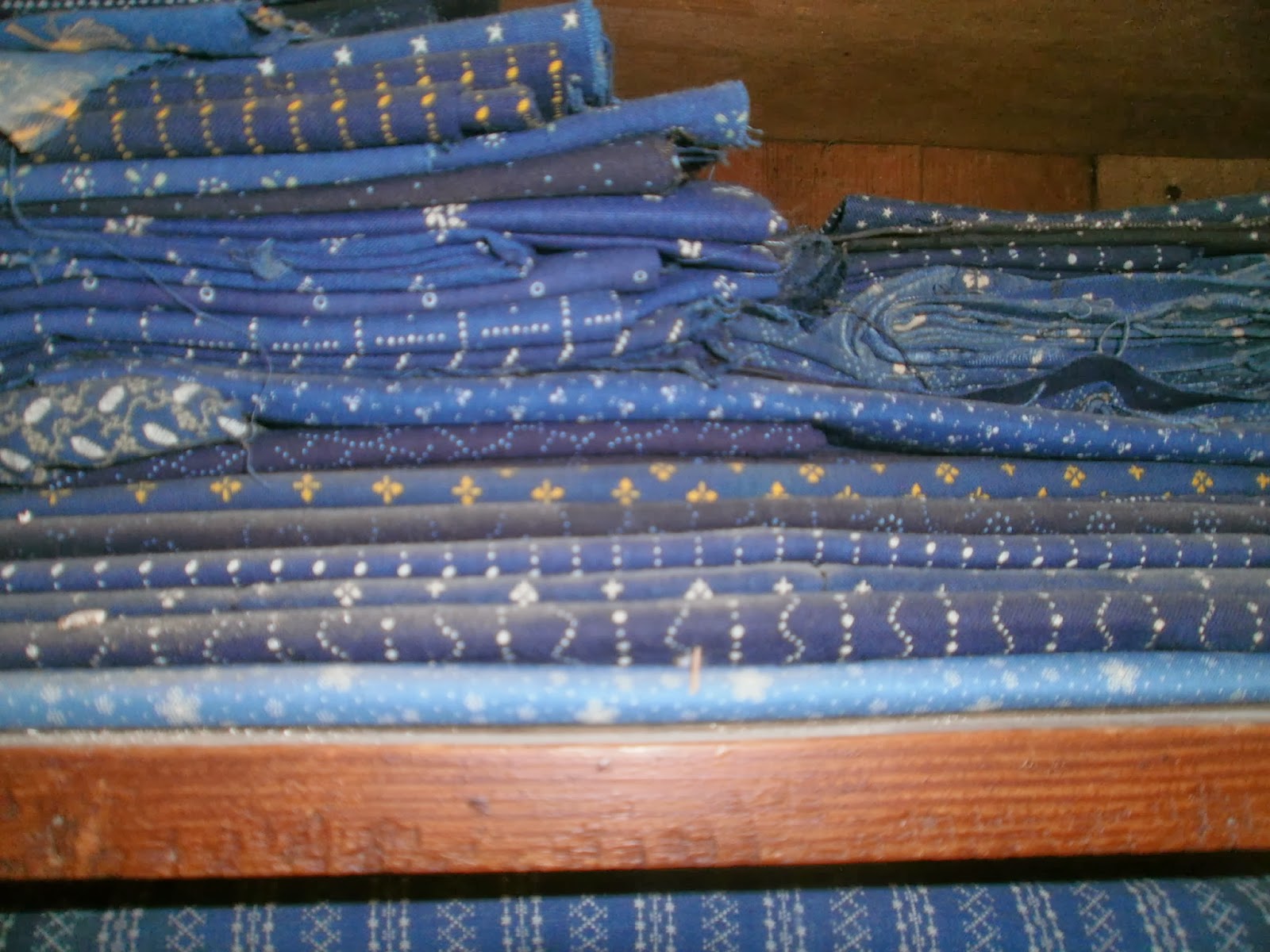It is now the Woolen mill sales room on the property of the Millwright hotel.
Saturday, October 8, 2022
Millwright Shop
Monday, March 28, 2022
Indigo Blue Calico
Indigo blue calico, my favorite fabric, was printed in Amana from 1861-1917, 4500 yards a day in its prime. Amana Calico was produced from the 1860’s until WWI when imports from Germany, which included the dyes needed for producing the cotton goods, were shut down. The last shipment of dye in 1916 kept the mills running for about a year, but once the supply was gone, the mills permanently closed. At the height of calico production in 1891, approximately 4000 -4500 yards of calico were printed each day. The mill or "print works" was located on the site of the present Amana Furniture Shop, the smallest brick building to the west being part of the original factory that employed 30 workers. The waterpower from nearby Price Creek was used to power the printworks mill. Designs were random geometric, floral, borders, and repeated stripes with about 500 patterns documented. The fabrics were used for summer work clothes, upholstery, curtains, quilts, etc. Many families dressed alike in this fabric. Calico patterns were printed with hand carved blocks, paste and acid resist rollers, and discharge print blocks. Dyes were special indigo plant dyes, when exposed to the air would oxidize and turn yellow-green to indigo. These dyes were not fast in the early days so would often leave residue on the pine benches and hands, only to be bleached clean later. The Print Works mill closed in 1917 due to the lack of imported dyes and supplies at the onset of WWI. The last shipment of indigo dye, processed and imported from Germany, was brought on a submarine that slipped through a net of British destroyers to complete a harrowing voyage from Bremenhaven to Baltimore. This submarine, it is said, may have carried a special envoy from Germany to Washinton D.C. to appeal to the USA not to enter WW1. But they did, so all dye and goods shipments ceased. The story of the sub and crew spread to the USA and quickly as it carried goods for Amana, Iowa, a German settlement. So naturally this kept people away from Amana as anti German feeing was at a high. Despite all this the printworks still provided a means to sustain the early Amana community. The printed fabric sold for a reasonable price and allowed working women to afford new and beautiful calico cloth for clothing, a treasure in life for most 19th century women. Today the German influenced, indigo calico dyed fabric, which is very rare and rich as ever, is much appreciated by viewers and collectors.
Saturday, March 26, 2022
The Bockwurst
One of the early signs of spring in the Amana Colonies is the making of the Bockwurst at the Amana Meat Market. It is an award winning sausage that some refer to as Easter Sausage as it is only available during Lenten season up to Easter.
Bockwurst is a German sausage first mentioned in 1827 in Bavaria area of Germany. An urban legend in Berlin claims that it was invented in 1889 by restaurant owner R. Scholtz of Berlin. It is one of the most popular varieties of delicious sausages in Germany, a source of much national pride and now found in many areas of the USA. Traditionally made of finely ground pork, veal, spices, and love, the Bockwurst is unlike the Bratwurst in that it contains a higher ratio of veal in its recipe. There are many variations of it in Germany but usually served with the spring release of dark Bock beer. So good...
Since 1856 Bockwurst has been made in the Amana Colonies using an award winning recipe that includes pork sausage, ground spices, and fresh green chives from garden beds. It is sold at the Amana Meat shop by the pound.
A traditional family German Bockwurst recipe is as follows:
400 g pork butter, trimmed
100 g back fat
100 g pork belly
18 g kosher salt
6 g onion powder
3 g white pepper
2 g sweet paprika
.5 g ginger
1 g nutmeg
1g whole coriander
1 g celery seed
1 tsp lemon zest
1 egg
100 ml whole milk
Grind all the meats, add egg, milk, spices into a food processor 30 sec. Stuff meat into standard 28-32 mm hog casings forming 4" links. Refrigerate up to 3 days, freeze 3 months.
This recipe is for 2.2 lbs or 7 links but you can easily scale to suit your needs. Recipe can be doubled. Guten Apetit and Brost!
Tuesday, March 8, 2022
Amana Church Cookie Walk
One of the highlights of the annual Prelude to Christmas celebration in the Amana Colonies the first weekend in December is the Church Society's Cookie Walk, hosted since 1991. If you like sweets this walk is for you!
Traditionally, cookies were a big hit at Christmastime everywhere especially in the Amanas, a German community. Christmas and Easter were the only times the Amana housewives baked cookies so they made lots and lots. Since there were no ovens in the homes all the cookie ingredients were premixed at home and the full bowls were then taken to the local bakery to be baked. This lasted all afternoon till dozens and dozens of many kinds of cookies were baked. Each family had an assigned time on a December afternoon to bake their creations. This baking lasted over 2-3 weeks in December. Fudge and candies were also made.
As in Germany, the Lebkuchen was most popular Christmas cookie. These were chewy honey cookies with hickory or walnuts, whiskey or citron added depending on the family's tradition. Free honey came from local apiaries as all versions needed two cups of honey to make this a long lasting cookie! After 1932 when the communal system ended, bakers had ovens in their own homes to bake cookies in their own kitchens.
To help celebrate this enthusiasm for Christmas cooking baking, local Church members now bake and make candies for the annual Amana Church Cookie Walk. Over 15,000 cookies baked by some 80 bakers, are arranged beautifully for shoppers to buy starting at noon after reserving a spot in the morning. Shoppers fill their own box, holding 4-5 dozen lovely cookies, for about 25.00. This popular event is well attended and sells out in about 3 hours. It benefits the Church's Sunday School and youth programs.
This year (2021) a Cookie Walk book was published, entitled Christmas Cookie Walk Favorites. 100 recipes are shared in the little book, each by an Amana Colonies baker and each with its own story. It is available at the local General Store, Amana Arts Guild, the High Amana Store, and the Heritage Museum of Amana History.
ALMOND APRICOT CHEWIES
2 CUPS SLIVERED ALMONDS
4 CUPS FINELY CHOPPED DRIED APPRICOTS
4 CUPS FLAKED SWEETENED COCONUT
1-14 OUNCE CAN SWEETENED CONDENSED MILK
3 TABLESPOONS FINELY CHOPPED PECANS
TOAST SLMONDS: Place almonds in a dry. Nonstick skillet and vook over medium heat, stirring occasionally, until nuts are lightly browned.
Combine toasted almonds, chopped apricots. Coconut and condensed milk.
Chill at least 2 hours
Shape dough into 1-inch diameter balls. Place in smaller or miniature foil candy liners. Top with a sprinkle of finely chopped pecans. Yield: 6 dozen
Subscribe to:
Comments (Atom)














